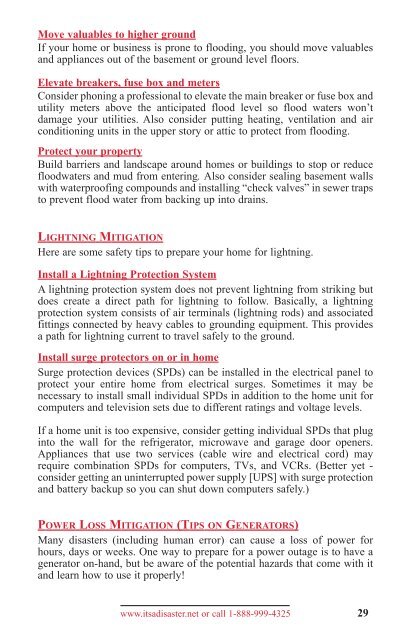disaster 5th 1108_5th ed 2011 - Homeland Security and Emergency ...
disaster 5th 1108_5th ed 2011 - Homeland Security and Emergency ...
disaster 5th 1108_5th ed 2011 - Homeland Security and Emergency ...
You also want an ePaper? Increase the reach of your titles
YUMPU automatically turns print PDFs into web optimized ePapers that Google loves.
Move valuables to higher ground<br />
If your home or business is prone to flooding, you should move valuables<br />
<strong>and</strong> appliances out of the basement or ground level floors.<br />
Elevate breakers, fuse box <strong>and</strong> meters<br />
Consider phoning a professional to elevate the main breaker or fuse box <strong>and</strong><br />
utility meters above the anticipat<strong>ed</strong> flood level so flood waters won’t<br />
damage your utilities. Also consider putting heating, ventilation <strong>and</strong> air<br />
conditioning units in the upper story or attic to protect from flooding.<br />
Protect your property<br />
Build barriers <strong>and</strong> l<strong>and</strong>scape around homes or buildings to stop or r<strong>ed</strong>uce<br />
floodwaters <strong>and</strong> mud from entering. Also consider sealing basement walls<br />
with waterproofing compounds <strong>and</strong> installing “check valves” in sewer traps<br />
to prevent flood water from backing up into drains.<br />
LIGHTNING MITIGATION<br />
Here are some safety tips to prepare your home for lightning.<br />
Install a Lightning Protection System<br />
A lightning protection system does not prevent lightning from striking but<br />
does create a direct path for lightning to follow. Basically, a lightning<br />
protection system consists of air terminals (lightning rods) <strong>and</strong> associat<strong>ed</strong><br />
fittings connect<strong>ed</strong> by heavy cables to grounding equipment. This provides<br />
a path for lightning current to travel safely to the ground.<br />
Install surge protectors on or in home<br />
Surge protection devices (SPDs) can be install<strong>ed</strong> in the electrical panel to<br />
protect your entire home from electrical surges. Sometimes it may be<br />
necessary to install small individual SPDs in addition to the home unit for<br />
computers <strong>and</strong> television sets due to different ratings <strong>and</strong> voltage levels.<br />
If a home unit is too expensive, consider getting individual SPDs that plug<br />
into the wall for the refrigerator, microwave <strong>and</strong> garage door openers.<br />
Appliances that use two services (cable wire <strong>and</strong> electrical cord) may<br />
require combination SPDs for computers, TVs, <strong>and</strong> VCRs. (Better yet -<br />
consider getting an uninterrupt<strong>ed</strong> power supply [UPS] with surge protection<br />
<strong>and</strong> battery backup so you can shut down computers safely.)<br />
POWER LOSS MITIGATION (TIPS ON GENERATORS)<br />
Many <strong>disaster</strong>s (including human error) can cause a loss of power for<br />
hours, days or weeks. One way to prepare for a power outage is to have a<br />
generator on-h<strong>and</strong>, but be aware of the potential hazards that come with it<br />
<strong>and</strong> learn how to use it properly!<br />
www.itsa<strong>disaster</strong>.net or call 1-888-999-4325<br />
29





